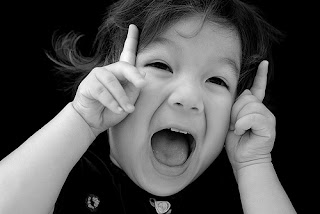How do we value a child's way of communicating and expressing themselves while building their competencies?
How do children express their wants and needs in a way that others can understand them better or so that children can understand others?
Romski, Sevcik, Adamson, Chelsock, Smith, Barker, et al. (2010), state that “For young children to develop functional communication skills, they must be able to comprehend and produce language that they can take on the roles of both listener and speaker” (p. 351).
Augmentative and Alternative Communication (AAC), according to Wikipedia: "...is any method that supplements or replaces speech and writing when these are temporarily or permanently impaired and inadequate to meet all or some of a person's communication needs...The user can use these elements alone or in combination in order to communicate a variety of messages" (Augmentative and Alternative Communication, n.d).
I think it is important to note that AAC does not appear to replace a child's voice but, can be used in combination with other forms of communication to enrich a child's level of fluidity and communication with others. As Buekelman and Mirenda (2002), reiterate “ Communication is multimodal in nature. AAC interventions should also be multimodal in nature” (p. 227).
Augmentative and alternative communication is very broad and includes a variety of communication methods.“AAC systems include manual signs, and gestures as well as speech-generating devices (SGDs) that produce digitized and /or synthesized speech” (ASHA 2002, as cited in Romski, et.al, 2010, p. 351).
 |
|
Working in a practicum with children with disabilities I was able use Augmentative and alternative communication with one of the children. This child Johnathon, had cerebral palsy and made choices through the use of Picture Communication Systems (PECS). He used his eye gaze when given two choices to choose the one he wanted. In circle we made picture cards for the songs we would sing. Johnathon was given a choice of two songs. He selected his preference by using a fixed eye gaze on one choice. In this offering it was an educator who chose the two options that Johnathon had to choose from. This choice was limited and controlled by adults. Is this enough of a choice when a child is only given two choices to choose from? What if Johnathon wanted Mary had a little lamb instead of Old McDonald and Twinkle, Twinkle Little Star? I always wondered this.
As educators we must ask ourselves, How will I make space for a child with Augmentative and alternative communication in my own classroom? Would I speak with the parents and professionals that are engaged with this child? How would I engage the children and prepare them to meet this child? Would I require extra support or learning in AAC? Would I open a child's information file to read their story? Or would I wait armed with some basic knowledge, to meet with the child to talk with them directly to find out their individual personhood, and needs?
As educators we must ask ourselves, How will I make space for a child with Augmentative and alternative communication in my own classroom? Would I speak with the parents and professionals that are engaged with this child? How would I engage the children and prepare them to meet this child? Would I require extra support or learning in AAC? Would I open a child's information file to read their story? Or would I wait armed with some basic knowledge, to meet with the child to talk with them directly to find out their individual personhood, and needs?
References
Augmentative and Alternative Communication. (n.d). Retrieved from:
http://en.wikipedia.org/wiki/Augmentative_and_alternative_communication#History_of_AAC
Beukelman, D.R., & Mirenda, P. (1998). Augmentative and alternative communication management of severe communication disorders in children and adults (2nd ed.). Baltimore, Maryland: Paul H. Brookes Publishing Co.
Q & A: How do you know when your child needs a speech and language device.(n.d). Retrieved from: http://lovethatmax.blogspot.com/2010/08/q-how-do-you-know-when-your-child-needs.html
Augmentative and Alternative Communication. (n.d). Retrieved from:
http://en.wikipedia.org/wiki/Augmentative_and_alternative_communication#History_of_AAC
Beukelman, D.R., & Mirenda, P. (1998). Augmentative and alternative communication management of severe communication disorders in children and adults (2nd ed.). Baltimore, Maryland: Paul H. Brookes Publishing Co.
Q & A: How do you know when your child needs a speech and language device.(n.d). Retrieved from: http://lovethatmax.blogspot.com/2010/08/q-how-do-you-know-when-your-child-needs.html
Romski, M.A; Sevcik, R.A., Adamson, L.B., Chelsock, M., Smith, A., Barker, R.M, et al. (2010). Randomized comparison of augmented and nonaugmented language interventions for toddlers with developmental delays and their parents. Journal of Speech, Language, and Hearing Research. 53, 350-364. Atlanta, Georgia: American Speech-Language-Hearing Association. Retrieved From: http://0-web.ebscohost.com.library.capilanou.ca/ehost/pdfviewer/pdfviewer?vid=3&hid=7&sid=6ab13bbb-bd4b-4c08-ad8e-6e0ebb1db064%40sessionmgr10

